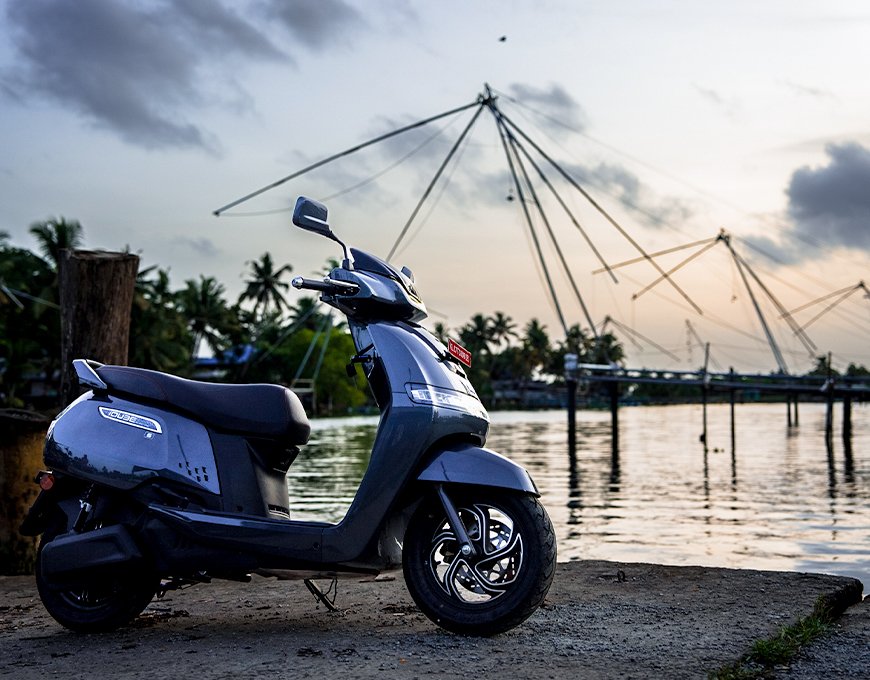Electric two-wheelers prove cost-effective in the long run due to lower operational and maintenance costs. Their upfront price is often offset by savings on fuel and repairs.
With the global push towards sustainability and the rising prices of gasoline, consumers are increasingly turning to electric two-wheelers as a practical alternative. These vehicles, which include electric scooters and motorcycles, offer a greener mode of transportation that can significantly reduce carbon footprint.
They harness the power of rechargeable batteries, eliminating the need for traditional fuel. As you consider the total cost of ownership, including purchase price, electricity costs, maintenance, and potential government incentives, electric two-wheelers emerge as an economically smart choice. Their popularity is also driven by their convenience for urban commuting, where short distances and traffic congestion make them an ideal option compared to cars.
With advances in battery technology and a growing network of charging infrastructure, electric two-wheelers are becoming an increasingly viable option for cost-conscious and environmentally aware consumers.
Table of Contents
Introduction To Electric Two-wheelers
Electric two-wheelers are a smart move towards sustainable travel. These vehicles rely on electric power over traditional fuel. Riding electric bikes and scooters offers a unique blend of efficiency and fun. They provide cost savings and are gentle on the environment.
The Rise Of Electric Bikes And Scooters
Electric bikes and scooters have gained popularity quickly. Many cities across the globe see them as the future of urban mobility. They lead to less traffic and pollution. People love their low running costs and ease of use.
- Lower maintenance costs – fewer moving parts
- No gas required – savings on fuel costs
- Eco-friendly – zero emissions
- Convenience – easy charging at home or office
Transition From Fuel To Electric Power
Switching from fuel to electric power is a key trend. The technology for electric two-wheelers keeps improving. Batteries get better and charge faster. Governments around the world promote electric vehicles with benefits and subsidies.
| Aspect | Fuel-Powered | Electric |
|---|---|---|
| Running Cost | Higher | Lower |
| Maintenance | Regular | Seldom |
| Eco Impact | Negative | Positive |
| Incentives | Less Common | More Common |
Investment Analysis Of Electric Two-wheelers
Understanding the true cost-effectiveness of electric two-wheelers involves looking at the big picture. It’s not just about the purchase price but also the long-term savings. Let’s explore these financial aspects in detail.
Upfront Costs Vs. Conventional Bikes
When considering electric two-wheelers, the initial expense is a critical factor. Here’s a comparison:
- Electric Two-Wheelers often carry a higher price tag due to advanced technology and batteries.
- Conventional Bikes are usually less expensive initially but have added costs like fuel and maintenance.
The comparison reflects an investment shift from ongoing fuel costs to upfront battery costs.
Government Incentives And Subsidies
Financial support from governments around the globe is changing the cost dynamics. Key points:
- Many governments offer purchase incentives which can reduce the initial cost significantly.
- Subsidies may include tax breaks, rebates, and special grants.
- These incentives aim to make electric two-wheelers more accessible and affordable.
Buyers should research local policies to understand available benefits.
| Aspect | Electric Two-Wheelers | Conventional Bikes |
|---|---|---|
| Upfront Cost | Higher | Lower |
| Ongoing Costs | Lower (electricity, less maintenance) | Higher (fuel, more maintenance) |
| Government Incentives | Available | Limited/None |
Battery Life And Replacement Costs
Thinking about battery life and replacement costs is key. Let’s explore how these factors affect the cost-effectiveness of electric two-wheelers over time.
Longevity Of Electric Vehicle Batteries
The heart of any electric two-wheeler is its battery. A high-quality battery can last between five to eight years. This varies based on usage and care. Proper maintenance can extend life. An electric two-wheeler’s battery degrades over time, losing capacity. Even with decreasing performance, they still provide ample range for daily commutes. Tech advancements are also pushing battery lifespans to new heights.
Cost Implications Of Battery Replacement
Battery replacement is a reality for long-term electric two-wheeler owners. The cost depends on the vehicle model and battery type. For instance, a lithium-ion battery might cost quite a bit, but they are becoming more affordable annually. The table below outlines some typical costs associated with battery replacement.
| Battery Type | Average Lifespan | Replacement Cost |
|---|---|---|
| Lithium-ion | 5-8 years | $250-$500 |
| Nickel-metal hydride | 6-10 years | $100-$300 |
| Lead-acid | 3-5 years | $75-$200 |
Remember, choosing a vehicle with a good warranty can reduce these costs. Some manufacturers offer extended warranties for their batteries. These warranties protect against premature failure and bring peace of mind.
Environmental Benefits And Savings
Choosing electric two-wheelers presents significant advantages for the planet and your wallet. Not only do they help preserve the environment, but they also contribute to substantial monetary savings in the long run. Let’s explore how electric scooters and bikes can make both a green and cost-effective impact.
Reduced Emissions And Pollution
Electric two-wheelers emit zero tailpipe pollutants. This drastic reduction in emissions helps to improve air quality. Here’s why electric vehicles are so beneficial:
- No gasoline means no harmful exhaust.
- Cleaner energy from renewable sources powers electric engines.
- Less smog and air pollution leads to healthier communities.
Indirect Cost Savings From Environmental Impact
Electric two-wheelers have a ripple effect on the economy. Here are some points on how environmental conservation translates into savings:
| Environmental Impact | Indirect Savings |
|---|---|
| Fewer Emissions | Lower healthcare costs due to clean air |
| Reduced Pollution | Decreased environmental cleanup expenses |
| Conservation of Resources | Savings on natural resources not exploited for fuel |
By protecting ecosystems, electric two-wheelers help conserve biodiversity. They also reduce the need for costly environmental restoration.
Every ride contributes to a greener planet and leaner expenses.

Credit: timesofindia.indiatimes.com
Operational Costs Compared
Wondering if electric two-wheelers save money over time? Operational costs matter. Let’s dive deep into the real costs of running electric two-wheelers compared to traditional gasoline bikes.
Electricity Vs. Gasoline Expenses
Think of energy expenses like a race. Electric two-wheelers are the clear winners, with electricity costs much lower than gasoline. Why? Charging a bike at home costs cents compared to dollars at the pump.
| Expense Type | Electric Two-Wheeler | Gasoline Bike |
|---|---|---|
| Energy/Fuel | Lower cost per mile | Higher cost per mile |
| Refueling/Charging Time | Convenient at home | Time-consuming at stations |
| Price Stability | More stable prices | Subject to market fluctuations |
Maintenance: Simplified Mechanics
With fewer moving parts, electric two-wheelers boast lower maintenance needs. Fewer oil changes, air filters, or spark plugs mean saving money and time.
- No engine oil changes
- Fewer mechanical parts to replace
- Regenerative braking reduces brake wear
Longevity often comes hand in hand with electric vehicles. They handle wear and tear like champs, meaning fewer trips to the service center.
Resale Value And Depreciation
When considering an electric two-wheeler (E2W), you think about the price you pay today. But, what about when you sell it? Let’s unpack the resale value and depreciation of E2Ws to understand their true cost.
Electric Two-wheelers’ Market Demand
Electric two-wheelers are buzzing on the streets and in the market. People want them more each day. Why? They’re clean, quiet, and cheap to run. This demand trickles down to the resale values too.
Think about it. Clean energy is big news. New buyers like the idea of an electric ride. That means your used E2W is a hot item when it’s time to sell.
- Battery health: Good battery life wins buyer’s hearts.
- Brand reputation: Top brands might fetch more money.
- Government incentives: More incentives can push demand.
Comparing Depreciation With Gas-powered Bikes
Gas-powered bikes drop in value faster than a stone in water. E2Ws? Not so much. They hold their worth better. This is a big deal for your wallet.
Here’s a quick comparison:
| Year | Electric Two-Wheeler | Gas-Powered Bike |
|---|---|---|
| 1st Year | 10% drop | 15% drop |
| 3rd Year | 20% drop | 30% drop |
| 5th Year | 30% drop | 50% drop |
E2Ws keep their value longer. Here’s why:
- Better battery technology
- Less moving parts to break
- Warranty deals on batteries
So, what’s the takeaway? E2Ws can be more kind to your future bank balance. Title your E2W well, and it might just give back good value when you’re ready to upgrade. Remember, with electric rides rising, your clever invest today could mean more cash tomorrow.
Infrastructure And Charging Costs
When considering the shift to electric two-wheelers, infrastructure and charging costs become vital factors. This influences their long-term cost-effectiveness. Exploring the infrastructure reveals if electric two-wheelers are a prudent choice for your daily commutes.
Availability Of Charging Stations
Electric two-wheelers depend on a robust network of charging stations. These stations need to be conveniently located and accessible. You can find station maps on many service provider websites or apps. The number and coverage of these stations are growing. This growth makes traveling longer distances worry-free. Look for:
- Station density in your area
- Different types of chargers available
- Operational hours for public access
Home Charging Setup And Costs
A home charging setup means charging overnight or between rides without hassle. Setting up requires a one-time investment. This setup includes the cost of a charging dock and possibly an electric upgrade to your home system. Most riders find it cost-effective due to:
- Lower electricity rates at night
- Local rebates or incentives for installation
- The convenience of charging at home
| Expense | Average Cost |
|---|---|
| Charging Dock | $200 – $500 |
| Installation | $500 – $1,200 |
| Monthly Electricity | $30 – $50 |
The table above summarizes the typical costs. These numbers can vary depending on the local rates and the type of charger. Compare these to your current spending on fuel. You will likely notice significant savings over time.
Long-term Market Projections
Wondering about the future of electric two-wheelers? Let’s dive into the long-term market projections.
Technology Advancements And Price Trends
Technology advancements continue shaping the electric vehicle (EV) industry. We can expect these changes:
- Better batteries with longer life spans and faster charging.
- More efficient motors that push the boundaries of speed and torque.
- Integrated smart technology for enhanced user experiences.
These improvements usually lead to higher costs initially. Yet, prices should drop due to:
- Scalability as production ramps up.
- Innovations that reduce manufacturing costs.
- Competition that drives prices down.
Predicting Future Cost-effectiveness
To predict future cost-effectiveness, we examine these factors:
| Factor | Impact on Cost-Effectiveness |
|---|---|
| Initial Purchase Price | Expected to decrease with tech and manufacturing improvements. |
| Running Costs | Remains low compared to gas-powered vehicles; savings increase over time. |
| Government Incentives | May reduce purchase price and overall costs in many regions. |
| Resale Value | Tends to improve as electric two-wheelers become mainstream. |
A simple look at these factors makes one thing clear. Electric two-wheelers are likely to become more affordable and cost-effective in the coming years.
Real-world Case Studies
Real-world case studies shine a light on the effectiveness of electric two-wheelers.
Riders across the globe are shifting gears to electric. Let’s delve into their stories and what numbers say.
Consumer Experiences And Testimonials
- Emma from California: “Cut fuel costs by 75% after switching to an electric scooter.”
- Raj from India: “Maintenance is so cheap; I save thousands every year!”
- Chen from China: “Battery life exceeded expectations, no regrets!”
These stories build a clear picture: savings are evident and satisfaction is high among electric two-wheeler owners.
Comparative Studies Of Ownership Costs
Numbers talk. Let’s compare the long-term expenses of conventional and electric two-wheelers.
| Cost Category | Electric Two-Wheeler | Gasoline Two-Wheeler |
|---|---|---|
| Fuel | Significantly lower | Higher |
| Maintenance | Minimal | More frequent |
| Depreciation | Slower | Faster |
| Total Cost Over 5 Years | Cost-effective | More expensive |
The lower lifetime costs of electric two-wheelers are clear. They offer a promising return on investment.
Conclusion: Making An Informed Decision
Deciding on an electric two-wheeler involves weighing various factors. This decision impacts your wallet, environment, and lifestyle long-term. Read on to balance the benefits and drawbacks and make a smart choice.
Balancing Pros And Cons
Electric two-wheelers boast numerous advantages. They are eco-friendly, reducing carbon emissions. Their low running costs save money on fuel over time. Yet, there are drawbacks. Higher upfront costs and concerns about battery life and charging infrastructure need consideration.
- Pros:
- Cheaper to operate than gas-powered bikes
- Minimal maintenance needs
- Eligible for government incentives
- Cons:
- Expensive initial investment
- Dependent on charging station availability
- Potential battery replacement costs
Final Verdict On Cost-effectiveness
After scrutinizing the expenses and benefits, electric two-wheelers prove to be cost-effective in the long haul. Their minimal environmental impact combined with the saving on fuel and maintenance costs make them a valuable choice. Nevertheless, evaluating the upfront cost against long-term savings is vital.
| Aspect | Electric Two-Wheeler | Gas-Powered Two-Wheeler |
|---|---|---|
| Initial Cost | Higher | Lower |
| Running Cost | Lower | Higher |
| Maintenance | Simpler and cheaper | More complex and costly |
| Environmental Impact | Reduced emissions | Higher emissions |
Individual circumstances differ. Assess personal requirements and potential savings. Research thoroughly, considering not only purchase price but also long-term operating costs. Be sure to factor in environmental benefits when calculating the overall value.
FAQ
What Are The Disadvantages Of Electric Scooters?
Electric scooters often have limited range and can struggle with hills. Battery life degrades over time, reducing performance. Initial costs and potential repair expenses can be high. Some areas lack adequate infrastructure, such as bike lanes, making them less safe on busy roads.
Charging can be inconvenient without easy access to power outlets.
Do Electric Scooters Save Money?
Electric scooters can save money on fuel, parking, and maintenance compared to traditional vehicles. They are cost-effective for short commutes and urban travel.
Is It Worth It To Get An Electric Scooter?
Electric scooters offer cost-effective, eco-friendly transportation; ideal for short commutes and urban living. Their low maintenance and convenience make them a worthy investment.
How Much Money Does It Cost To Charge An Electric Scooter?
Charging an electric scooter generally costs between $0. 03 and $0. 10 per charge, depending on your local electricity rate.
Bottom Line
Concluding, electric two-wheelers offer a promising avenue for economical travel. Over time, their low maintenance and fuel costs balance initial investments. As technology advances, these vehicles stand as a testament to sustainable and cost-effective transportation. Embracing them aligns financial savvy with eco-conscious living, marking a stride toward a greener future.




Leave a Reply